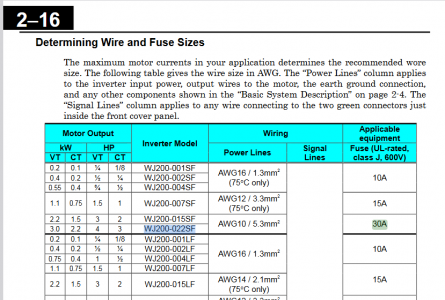Only trying to help....
Many sizes, models, and quality of VFDs out there, and yes a lot of opinions about what these things should do and how they should perform. These conversations are tainted by the concept of a generic VFD and many different installations. So, for the most part, I went by the manufacturer's specs and instructions.
There are two main issues associated with wire size. 1) Is the load so large that the wire gets hot and causes a fire. 2) Is the wire so small that it supplies a smaller voltage to the load than the load wants to see causing the load (VFD or motor) to fail (similar to a brown out). In the end you get to decide what you want to do as long as it meets electrical code (or that no one ever finds out). The fuse size, and code to some extent, simply tries to prevent item 1, the fire problem.
This is the model I mentioned that I used for my PM1440GT (3HP 3Phase) conversion:
The 420 page manual is here: https://www.hitachi-iesa.com/sites/default/files/supportdocs/WJ200_Instruction_NT325X.pdf
Hitachi WJ200-022S Model:
Input voltage: S=Single-phase 200V class, if there is an extra F at the end it stands for the keypad type
Applicable motor capacity in kW: 022 = 2.2kW
In the manual, it says for this 2.2kW device the input should be fused at 30A and the wire size should be 10AWG. See the attached table.
I suppose these specs. also try to take into account the fact that power line input voltage can vary, the inverter is not 100% efficient, and that the output voltage, frequency, internal switching frequency, and load can vary; and the inverter is designed to control acceleration both during start up and during braking. Of course there are other differences such as the work environment/temperature.
By the way, the 2.2kW is the steady state maximum output power to the motor, not the input power to the VFD, nor it is the instantaneous or peak power. I suppose if you are never going to load the motor down then the over all power needed can certainly be less. (A compressor is an ideal example of the issues. A compressor takes a lot more current to start up when the tank is already partly pressurized than when it is empty. This is because the load is much larger. It takes longer for the motor to start, drawing a lot more current during startup. Hence, it requires a much larger fuse to get started than to run once it is up to speed.)

The model 022L requires a higher temperature wire and then it can be connected via 12AWG.
Good Luck
Dave L.
Many sizes, models, and quality of VFDs out there, and yes a lot of opinions about what these things should do and how they should perform. These conversations are tainted by the concept of a generic VFD and many different installations. So, for the most part, I went by the manufacturer's specs and instructions.
There are two main issues associated with wire size. 1) Is the load so large that the wire gets hot and causes a fire. 2) Is the wire so small that it supplies a smaller voltage to the load than the load wants to see causing the load (VFD or motor) to fail (similar to a brown out). In the end you get to decide what you want to do as long as it meets electrical code (or that no one ever finds out). The fuse size, and code to some extent, simply tries to prevent item 1, the fire problem.
This is the model I mentioned that I used for my PM1440GT (3HP 3Phase) conversion:
The 420 page manual is here: https://www.hitachi-iesa.com/sites/default/files/supportdocs/WJ200_Instruction_NT325X.pdf
Hitachi WJ200-022S Model:
Input voltage: S=Single-phase 200V class, if there is an extra F at the end it stands for the keypad type
Applicable motor capacity in kW: 022 = 2.2kW
In the manual, it says for this 2.2kW device the input should be fused at 30A and the wire size should be 10AWG. See the attached table.
I suppose these specs. also try to take into account the fact that power line input voltage can vary, the inverter is not 100% efficient, and that the output voltage, frequency, internal switching frequency, and load can vary; and the inverter is designed to control acceleration both during start up and during braking. Of course there are other differences such as the work environment/temperature.
By the way, the 2.2kW is the steady state maximum output power to the motor, not the input power to the VFD, nor it is the instantaneous or peak power. I suppose if you are never going to load the motor down then the over all power needed can certainly be less. (A compressor is an ideal example of the issues. A compressor takes a lot more current to start up when the tank is already partly pressurized than when it is empty. This is because the load is much larger. It takes longer for the motor to start, drawing a lot more current during startup. Hence, it requires a much larger fuse to get started than to run once it is up to speed.)

The model 022L requires a higher temperature wire and then it can be connected via 12AWG.
Good Luck
Dave L.

